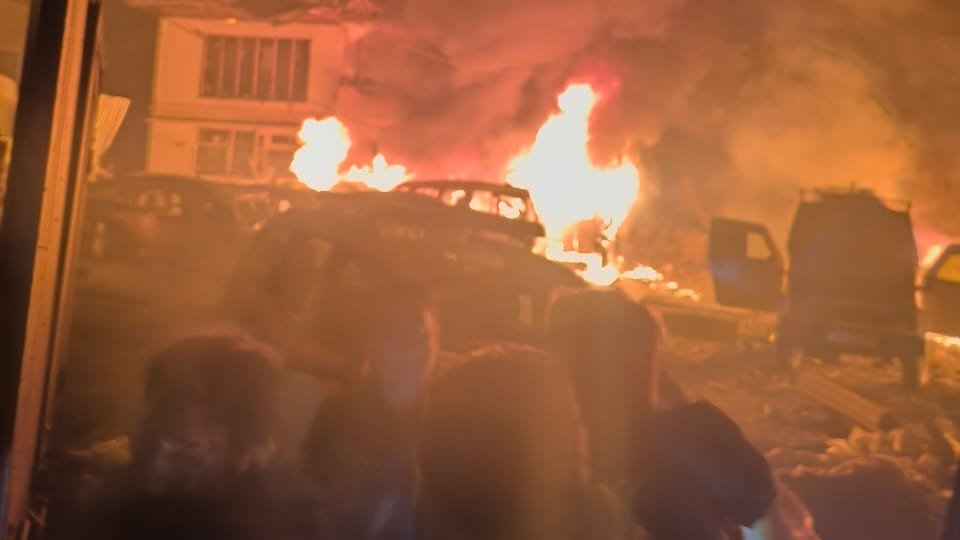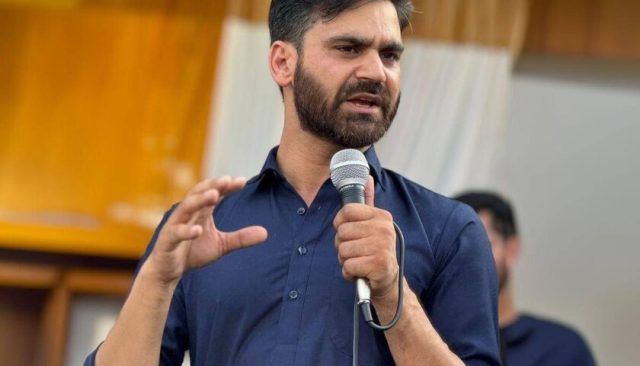Nowgam Police Station Blast: Inside the Deadly Srinagar Explosion That Killed 9 and Injured 29 — A Full Report
By: Javid Amin | 15 November 2025
A Tragedy Born In A Room Full Of Explosives
The explosion that ripped through Nowgam Police Station in Srinagar was not just another accident. It was a tragedy born of a massive security miscalculation—an explosion so powerful that bodies were flung up to 300 meters away, vehicles were mangled beyond recognition, and an entire police station was left in ruins.
This was not a terror attack.
This was a preventable internal catastrophe during inspection of explosives seized in connection with the November 10 Red Fort car blast in Delhi.
Nine people—including a Naib Tehsildar, police personnel, and forensic staff—lost their lives.
Twenty-nine others suffered injuries, several in critical condition.
As ground reports reveal, the explosives were part of a larger white-collar radicalisation module spread across multiple states, involving doctors, paramedics, clerics, and professionals—a chilling evolution of terrorism in India.
This comprehensive 5000+ word investigative article breaks down:
-
What happened during the explosion
-
Verified facts on the seized explosives
-
The white-collar terror module behind the Red Fort blast
-
Massive security lapses that allowed the tragedy
-
Political and public reactions
-
Context of ongoing crackdowns in Kashmir
-
Future implications for India’s counter-terror strategy
The Moment Of The Blast — What Exactly Happened
01. A Routine Forensic Inspection That Turned Fatal
The blast occurred around late afternoon inside the Nowgam Police Station compound when a team of:
-
Forensic Science Laboratory (FSL) experts
-
Police officers
-
Civil administration staff, including a Naib Tehsildar
were examining an extremely large cache of explosive material seized from Faridabad.
The seized items reportedly included:
-
2,900 kg of ammonium nitrate
-
Remote switches
-
Detonators
-
Electronic trigger systems
-
Metal shrapnel elements
-
Bomb-making gel mixtures
-
Unassembled devices
Verified ground reports confirm that a portion of this seizure was transported to Srinagar for forensic analysis in connection with the Red Fort car blast case.
02. The Explosion That Shook the Region
When the officers began sampling the materials—likely drilling, scraping, or opening containers—a sudden ignition triggered a massive explosion.
The blast:
-
Tore through the main building
-
Shattered windows in a 300–400 meter radius
-
Sent shockwaves that were heard up to 30 km away
-
Threw debris high into the air
-
Caused multiple secondary explosions from nearby stored items
Security teams described the scene as a war-zone-like destruction.
03. Why Bodies Were Thrown So Far
Ammonium nitrate, when combined with fuel or detonators, behaves like TNT.
The force of the explosion:
-
Tore through reinforced walls
-
Launched bodies and debris hundreds of meters
-
Cavitated the ground inside the compound
-
Uprooted parked vehicles
-
Created a mushroom-type cloud visible from several kilometers
Initial speculation suggested a coordinated attack, but MHA clarified it was purely accidental.
The Explosive Cache: Origin, Nature & Connection To Terror Modules
01. The Faridabad Seizure: One of the Largest in Recent Years
Just days earlier, authorities had seized 2,900 kg of explosive chemicals from a rented accommodation in Faridabad, Haryana.
The rental was linked to Dr. Umar Nabi, a medical professional suspected of involvement in the Red Fort blast.
02. Composition of the Seized Material
Based on cross-verified reports, the seized cache included:
-
Industrial-grade ammonium nitrate
-
Improvised Explosive Device (IED) components
-
Printed circuit boards
-
Power sources
-
Remote detonation devices
-
High-intensity chemical mixtures
-
Containers marked with coded labels
Such an elaborate setup suggests industrial-scale terror preparation.
03. Transfer to Srinagar: Why the Materials Were Moved
Officials transported part of the explosive material to Srinagar for:
-
Forensic testing
-
Chemical profiling
-
Cross-matching with explosives used in Red Fort blast
-
Gathering legal evidence for chargesheets
This transfer, although standard, should never have been stored inside a functioning police station, especially in a populated area.
The Red Fort Terror Link — A White-Collar Radicalisation Network
01. A Terror Module Unlike the Past
Authorities describe the network as a white-collar terror module, involving:
-
Doctors
-
Paramedics
-
Clerics
-
University students
-
Skilled technicians
-
Individuals with no criminal backgrounds
This indicates a shift from traditional militant structures to educated, urban radicalised professionals.
02. Alleged Operator: Dr. Umar Nabi
Reports indicate:
-
Dr. Umar is believed to be the driver of the car that exploded near Red Fort
-
His Pulwama property was demolished after explosives were found
-
He had rented the Faridabad unit used to store explosives
-
He allegedly coordinated logistics for the module
-
He is suspected to have fled to Afghanistan
-
Interpol Red Corner Notice is being initiated
03. Why This Module Is Dangerous
This network is dangerous because:
-
They have education, resources, and mobility
-
They hide behind professional identities
-
They can recruit unsuspecting youth and colleagues
-
They can procure chemicals without raising suspicion
-
They can plan large-scale attacks using scientific knowledge
The Nowgam blast unexpectedly exposed the scale of what authorities were dealing with.
Inside The Tragedy — Casualties, Rescue & Response
01. Lives Lost
Among the deceased:
-
A Naib Tehsildar, part of the evidence inspection team
-
Police personnel
-
Forensic staff
-
Possibly civilian employees present during documentation
Their bodies were so badly damaged that identification required advanced forensic methods.
02. Injured Personnel
At least 29 people sustained injuries:
-
Severe burn injuries
-
Blast trauma
-
Fractures from impact
-
Lacerations from shrapnel
-
Lung injuries due to shockwave
03. Rescue Amid Chaos
Emergency responders rushed to the scene:
-
Fire services
-
SDRF
-
J&K Police Quick Reaction Teams
-
Army units from nearby installations
Sniffer dogs and bomb squads scanned the area for possible secondary triggers.
04. Hospital Response
Victims were shifted to:
-
SMHS Hospital, Srinagar
-
92 Base Hospital (Army hospital)
Deputy Commissioner Akshay Labroo personally oversaw medical arrangements.
Investigation & Security Lapses — What Went Wrong
01. Forensic Handling Error (Official Version)
The MHA has confirmed:
-
The blast was accidental, not a terror attack
-
It happened during sampling and examination
-
No external interference has been detected
02. Why Were Explosives Stored in a Police Station?
This is the biggest unanswered question.
Police stations:
-
Are not reinforced bunkers
-
Have daily civilian traffic
-
Lack climate-controlled explosive chambers
-
Are located in residential areas
-
Are not designed to store bulk explosives
This raises serious procedural lapses.
03. Failure of Standard Operating Procedures (SOPs)
Proper handling demands:
-
Isolated explosive storage
-
Fireproof chambers
-
Remote-handled robotic sampling
-
Temperature monitoring
-
Restricted human presence
None of these were reportedly in place.
04. Why Was a Naib Tehsildar Present?
Civil officers participate in:
-
Seizure documentation
-
Evidence verification
-
Legal oversight
But their presence during active sampling of explosives is questionable.
05. Political & Public Pressure
Leaders across parties have demanded:
-
A judicial inquiry
-
Accountability for negligence
-
Clear reforms in explosive storage protocols
-
Independent oversight mechanisms
Public anger is particularly strong because this accident was entirely preventable.
Kashmir’s Current Security Landscape — Context Matters
The blast comes amid a massive crackdown in the Valley following the Red Fort explosion.
01. 600+ Detentions
Police and NIA reportedly detained over:
-
600 individuals
-
Including clerics, doctors, teachers, students
02. 500+ Raids
Search operations were conducted across:
-
Pulwama
-
Srinagar
-
Shopian
-
Baramulla
-
Anantnag
-
Kulgam
03. International Link: Afghanistan
The primary handler, allegedly Dr. Muzaffar, is thought to be hiding in Afghanistan.
Public Reaction — Grief, Outrage & Questions
01. Shock Across the Valley
Residents described:
-
A deafening blast
-
Houses shaking
-
Windows shattering
-
Smoke rising from the station
Panic spread rapidly.
02. Political Statements
Leaders demanded:
-
Transparent updates
-
Accountability
-
SOP reforms
-
Independent oversight of evidence handling
03. Civil Society Response
Activists questioned:
-
Why such dangerous materials were stored irresponsibly
-
Whether citizens were put at risk intentionally or negligently
-
Why there was no communication or warning
Long-Term Implications For India
01. Need for Specialized Explosive Storage Facilities
India urgently needs:
-
Centralized explosive vaults
-
Blast-resistant forensic labs
-
Temperature-controlled bunkers
-
Robotic sample handlers
02. Monitoring White-Collar Terror
A new threat category:
-
Educated radicals
-
Urban operatives
-
Cross-state networks
-
Professional extremist cells
03. Legal, Administrative & Procedural Reforms
Future reforms must include:
-
Revised SOPs
-
Accountability for lapses
-
Mandatory training for police
-
External audits of high-risk storage
Conclusion — A Tragedy That Should Never Have Happened
The Nowgam Police Station blast is more than an accident.
It is a failure of procedure, oversight, and risk assessment.
It is a warning—a deadly one—that explosives seized in terror cases cannot be handled casually, especially not inside civilian zones.
Nine lives were lost.
Twenty-nine survivors will carry scars forever.
And Kashmir witnessed a tragedy that could have been avoided with one simple thing:
Proper storage and handling of explosives.
This incident will likely shape India’s counter-terror reforms, forensic procedures, and security infrastructure for years to come.




